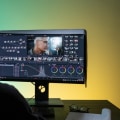Are you interested in creating your own movie with making software? It can be a daunting task to get started, but with the right tips and tricks, you can become a movie making expert. From choosing the right software, to understanding the technical aspects of editing and filming, this article will provide you with all the information you need to create a stunning movie. Whether you're a beginner or a seasoned filmmaker, these tips will help you create a movie that looks professional and is sure to draw viewers in.
Planning Your Movie:
Making a movie with software is an exciting and rewarding experience, but it takes planning and creativity. Before you start, decide on a plot, storyboard your ideas, and set up a production schedule.This will help ensure your project runs smoothly.
Preparing the Software:
Once you’ve outlined your project, it’s time to pick the right software and tools for your movie. Research the available software and choose one that meets your needs. Then, make sure to learn how to use it properly and set up the necessary tools. This will save you time and energy when you start making the movie.Making the Movie:
Now it’s time to start recording footage.Capture the clips that will bring your story to life. Then, edit the clips together, add audio and special effects, and perfect the final product. If you plan your scenes and take your time, you’ll end up with a great movie.
Sharing Your Movie:
After all your hard work, it’s time to share the movie with your audience. Upload the movie to popular platforms like YouTube or Vimeo and market it to reach more viewers.Make sure to post it on social media too and send it out to any contacts you have in the industry. With a bit of work, you can make sure everyone sees your movie.
Sharing Your Movie
Once you have finished creating your movie, it's time to share it with the world! You can upload your movie to popular platforms, such as YouTube, Vimeo, and Dailymotion. You can also market your movie using social media platforms like Facebook and Twitter. When uploading your movie, make sure to include relevant tags and descriptions so that viewers can easily find your video.Consider also creating an engaging thumbnail image that viewers will be drawn to when searching for content. In addition to uploading your movie to video-sharing platforms, you can also create a website or blog to host your movie. This allows you to give viewers more information about your movie and allows them to easily download or stream the movie. Finally, don't forget to promote your movie! Use social media platforms to get the word out about your movie, create promotional videos and images, and consider attending film festivals or other events to showcase your work.
Making the Movie
Making a movie with software is an exciting and creative process. To get started, you need to record footage and edit clips.This could include adding audio, special effects, and perfecting the final product. The first step is to decide on the type of movie you want to create and what kind of equipment you will need. You may need a camera, microphone, or other recording devices depending on your project. Once you have everything you need, you can start recording.
When recording, make sure you capture all the essential moments in your movie. Take extra care to ensure that the audio quality is good and that the visuals look professional. Once you have all the footage you need, it's time to start editing. Editing is where the magic happens! You can cut out any unnecessary scenes, add transitions, combine audio and video clips, add special effects, and more.
When editing your movie, remember to keep an eye on the overall flow and story arc. Pay attention to how different shots fit together and how they tell your story. Finally, when you are happy with the finished product, it's time to perfect it. This could include adding titles and credits, color correcting or adding filters, or adding music or sound effects.
Make sure everything looks perfect before you release your movie!
Planning Your Movie
Making movies with software can be an exciting and rewarding experience, but it takes careful planning, creativity, and patience to make sure your project is successful. Here are some tips to help you get started:Brainstorm IdeasBrainstorming is an important first step in the movie-making process. Make sure to come up with a clear concept for your movie and think about what kind of story you want to tell. It can be helpful to write down ideas, draw storyboards, and create a mood board for inspiration.Create a Storyboard
Once you've settled on a concept, it's time to create a storyboard.This is a visual outline of your movie that will serve as a roadmap for the production process. Storyboards should include sketches or images of each scene, along with descriptions of the action and dialogue.
Set Up a Production Schedule
Before you start shooting, you should also create a production schedule. This will help you stay organized and make sure that you complete your movie on time. The production schedule should include dates for all key tasks such as writing, pre-production, shooting, editing, and post-production. By taking the time to plan out your movie before beginning production, you can ensure that your project is successful.With careful planning and creativity, you can create an amazing movie experience for yourself or your audience.
Preparing the Software
Researching and Choosing the Right SoftwareWhen it comes to making movies with software, the most important step is researching and choosing the right software for your project. Different types of software offer different features, so make sure you understand the capabilities and limitations of each before you commit. Consider the type of movie you want to make and the type of software that will best support it. If you're creating a documentary, for example, you'll need software that enables you to edit video clips and add effects. If you're making an animated movie, you'll need software that supports 2D or 3D animation.Learning How to Use the Software
Once you've chosen the right software for your project, it's time to learn how to use it.Many software packages come with tutorials or user manuals that can help you get started. It's also a good idea to look up video tutorials online and watch demonstrations of how to use the software. If you're new to movie-making, it can be helpful to start with basic editing techniques before moving on to more advanced techniques. It may take some practice before you feel comfortable using the software, so be patient with yourself.
Setting Up Any Necessary Tools
In addition to the software itself, there are other tools and accessories you may need in order to make your movie. This could include a camera, microphone, lighting equipment, or even a green screen.Make sure you have all the necessary tools before you begin. Once your tools are set up and ready to go, you can start creating your movie. With some planning, creativity, and patience, you can create an amazing movie experience for yourself or your audience. Creating a movie with making software can be an enjoyable, creative and rewarding experience. It is important to plan out the movie before beginning production, as this will ensure that you have the necessary resources and timeframe to complete the project. Preparing the software is also essential for a successful movie-making experience, as it will ensure that the software is compatible with the necessary media files.
Once the software is ready, you can begin the process of making the movie. Finally, once the movie is complete, you can share it with an audience by uploading it to streaming services or other media platforms.











